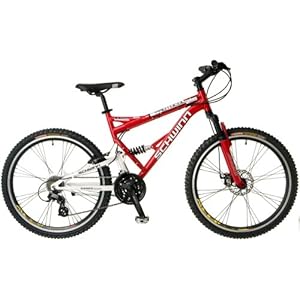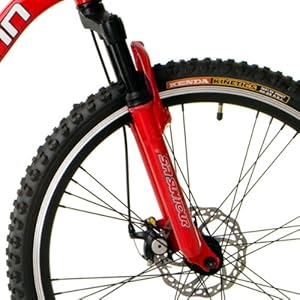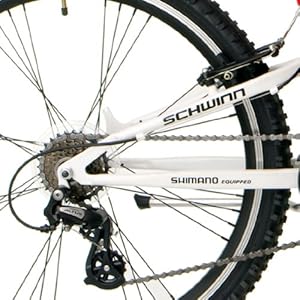What is a mountain bike? In thinking about the type of cycling you want to do, if you plan on doing a lot of off-road riding, like zipping through the woods or traveling across desert areas on sandy or rocky trails, a mountain bike is probably what you need. Buying a mountain bike however, can be an expensive business, with entry level bikes going for about $250 to $300 and some of the top models selling from $4000 to $5000 and even more.
 |
| Schwinn Dual-Suspension Mountain Bike |
Wheels: Mountain bikes usually have wide knobby tires that offer more substantial grip and traction over bumps and on a variety of surfaces, including dirt, gravel, rocks and sand. Tire pressure on mountain bikes is less than on road bikes, due to their greater volume and better traction offered by the softer tire. The rims and spokes on a mountain bike are stronger and more durable enabling it to handle the rough riding that mountain biking consists of.
Frame: The key factors to consider in choosing which frame material is right for you, depend on your own level of commitment and of course, your budget. There are four types of frames to consider and as the materials get more advanced, the price increases.
- Steel: Most entry-level mountain bike frames are steel (also called “cro-moly”), due to the strength and durability the material offers and the low price of steel, relatively speaking. The fallback of steel is its weight and that it is susceptible to rust. For many non competitive riders, where weight is not much of a deciding factor, a steel frame is probably fine.
- Aluminum: A good lightweight, rust-proof and relatively strong frame is aluminum. But over time and when subjected to repeated stress is prone to break. I would not recommend aluminum frames for mountain biking, simply due to the rough nature of off road riding, which constantly subjects the frame to significant stress, particularly when a heavier rider is involved.
- Carbon fiber: The next higher level of material and similar to aluminum in being lightweight rust-proof and very strong is carbon fiber. Carbon fiber frames may be suitable for the average or smaller sized riders, but the stress of mountain biking can also lead to breakage. Keep in mind, when they go it happens suddenly, usually resulting with much inconvenience.
- Titanium: A titanium frame on a mountain bike is an excellent choice for large riders because of its ability to handle heavy loads without becoming fatigued. It is super light and incredibly strong. The bad news is, titanium is very expensive. Because of the cost, bikes with titanium frames usually fall way above the range of all but the most serious and competitive cyclists.
Handlebars: Mountain bike handlebars are basically flat, and go straight out from the stem. With a wider grip, usually about shoulder width, these handlebars allow riders to sit upright and offer a better position for vision and control of the bike on up and down hill terrain.
Riding position: The way that a mountain bike is designed allows riders to sit upright in a position that gives them the best control of the bike, with a well-placed center of gravity and the ability to shift weight forward or backward to provide balance and adjust to the varying terrain.
Gears: Mountain bikes have a wide range of gearing to allow them to handle a broad range of terrain. With low gears that go well below that of most road bikes, riders are more easily able to conquer some very steep hills. On the high end of the gear range, mountain bikes typically are not so tall in the gearing as what you’d find on a road bike. Rarely is there the need for wide-open, racing speed such as you’d have on a road bike, and the bike’s over-sized, knobby tires are not really appropriate for going super fast anyway.
A mountain bike will have either two or three chain rings in the front as part of the crank assembly, again smaller than what you’d find on a road bike, along with eight or nine gears in the cassette on the rear wheel, many times featuring one impressively-sized gear called a “granny gear” to help with the particularly steep climbs. This combination allows for anywhere from 16 to 27 possible gear combinations, a range that accounts for virtually every type of terrain that a mountain bike will cross over.
Pedals: Basic mountain bikes come equipped with platform pedals. This is useful if you’re the type of rider who frequently puts your feet down. Other more advanced riders may prefer to use toe clips or even clip-less pedals that allow the rider to secure his or her cleated shoes to the pedals.
Accessories: Mountain bikes may include cyclocomputers, frame pumps, tool bags, water bottles and cages. Also, because of the rugged nature of mountain biking and the frequent distances from “civilization” that it entails, many mountain bikers carry tool kits with extra tools and replacement parts that road bikers need not bring.
Buying Advice: Be sure you will be doing plenty of off-road riding before you decide to buy a mountain bike. If you are just going to be riding mostly in town or on paved or hard smooth flat trails, there are better bike choices that will be more comfortable and serve you better, such as hybrids, cruisers or road bikes.
Also, beware of cheap, heavy mountain bikes sold by box stores like Target and Walmart. Though they may offer snazzy-looking front and rear shock set-ups, generally these add a lot of weight to the frame, and being made from cheap components, they wont last very long under the types of rugged riding conditions they encounter.
Some Major Brands specializing in mountain bikes are Giant, Specialized, Gary Fisher, Trek, Diamondback, Kona, Charge, NS Bikes, Mongoose, Orbea, Revell, Yeti, Orange and Schwinn.
Safety: Always Be Safe and wear a helmet. Make sure you have a CPSC-approved bike helmet that fits properly. It should not wobble or flop around on your head when your chinstrap is buckled. Even with a great helmet, you might be unconscious if you crash. Carry ID, any important medical info, emergency contacts, and your insurance information. Adequate clothing, gloves and shoes are also recommended. It’s also a good idea to carry a cellphone, just in case.
that fits properly. It should not wobble or flop around on your head when your chinstrap is buckled. Even with a great helmet, you might be unconscious if you crash. Carry ID, any important medical info, emergency contacts, and your insurance information. Adequate clothing, gloves and shoes are also recommended. It’s also a good idea to carry a cellphone, just in case.
Check out "Should I Get Shocks On My Mountain Bike"
Check out "Should I Get Shocks On My Mountain Bike"


No comments:
Post a Comment